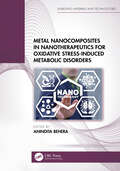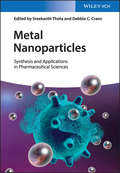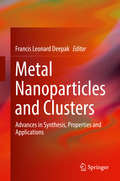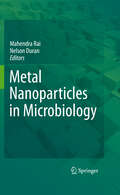- Table View
- List View
Metal-Ligand Co-operativity: Catalysis and the Pincer-Metal Platform (Topics in Organometallic Chemistry #68)
by Gerard Van Koten Karl Kirchner Marc-Etienne MoretThis book provides researchers in the fields of organic chemistry, organometallic chemistry and homogeneous catalysis with an overview of significant recent developments in the area of metal-ligand cooperativity, with a focus on pincer architectures. The various contributions highlight the widespread impact of M–L co-operativity phenomena on modern organometallic chemistry and catalyst development. The development of efficient and selective catalytic transformations relies on the understanding and fine control of the various elementary reactions that constitutes a catalytic cycle. Co-operative ligands, which actively participate in bond making and bond breaking together to the metal they support, open up new avenues in this area. In particular, buttressing a weak or reactive metal-ligand bond by flanking coordinating arms in a pincer ligand design is proving a versatile strategy to access robust metal complexes that exhibit unusual and selective reactivity patterns.
Metal-Ligand Interactions: Structure and Reactivity (Nato Science Series C: #474)
by N. Russo Dennis R. SalahubMetal-Ligand Interactions - Structure and Reactivity emphasizes the experimental determination of structure and dynamics, supported by the theoretical and computational approaches needed to establish the concepts and guide the experiments. Leading experts present masterly surveys of: clusters, inorganic complexes, surfaces, catalysis, ab initio theory, density functional theory,semiempirical methods, and dynamics. Besides the presentations of the fields of study themselves, the papers also bring out those aspects that impinge on, or could benefit from, progress in other disciplines. Refined in the fire of an interactive and stimulating conference, the papers presented here represent the state of the art of current research.
Metal-Ligand Interactions: Molecular, Nano-, Micro-, and Macro-systems in Complex Environments (NATO Science Series II: Mathematics, Physics and Chemistry #116)
by N. Russo Dennis R. Salahub Malgorzata WitkoIn September 2002, a NATO-ASI was held in Cetraro (CS), Italy on the theme of "Metal-Ligand Interactions in Molecular-, Nano-, Micro-, and Macro-systems in Complex Environments". This event has followed the previous ones held in the same place in 1991, 1994 and 1998. In the present and the previous schools a broad interdisciplinary cross-section of experimental and theoretical researchers, interested in a better understanding of metal-ligand interactions from different viewpoints, was linked together to exchange experience, to review the state-of-the-art, to indicate new techniques and methods, to explore new fields and perspectives. Particular emphasis was given to the problems related with the crossing from molecular systems to nano-, macro-and micro-scale materials and to the effects of the environment on the properties of the molecular systems. The school was organized around lectures and special research seminares given by leading experts in the following fields: • metal clusters • inorganic complexes and materials • surface phenomena • adsorption and catalysis • organic and bio-inorganic systems • ab initio theory • density functional theory • classical and quantum dynamics This volume contains the formal lectures and selected contributed papers and describes the main aspects and problems tackled during the 12 days of the event.
Metal-Ligand Interactions: From Atoms, to Clusters, to Surfaces (Nato Science Series C: #378)
by Dennis R. Salahub N. RussoMetal-ligand interactions are currently being studied in different fields, from a variety of points of view, and recent progress has been substantial. Whole new classes of compounds and reactions have been found; an arsenal of physical methods has been developed; mechanistic detail can be ascertained to an increasingly minute degree; and the theory is being developed to handle systems of ever-growing complexity. As usual, such multidisciplinarity leads to great opportunities, coupled with great problems of communication between specialists. It is in its promotion of interactions across these fields that Metal-Ligand Interactions: From Atoms, to Clusters, to Surfaces makes its timely contribution: the tools, both theoretical and experimental, are highly developed, and fundamental questions remain unanswered. The most fundamental of these concerns the nature of the microscopic interactions between metal atoms (clusters, surfaces) and ligands (atoms, molecules, absorbates, reagents, products) and the changes in these interactions during physical and chemical transformation. In Metal-Ligand Interactions, leading experts discuss the following, vital aspects: ab initio theory, semi-empirical theory, density functional theory, complexes and clusters, surfaces, and catalysis.
Metal-Ligand Interactions in Chemistry, Physics and Biology (Nato Science Series C: #546)
by N. Russo Dennis R. SalahubProceedings of the NATO Advanced Study Institute, held in Cetraro (CS) Italy, from 1-12 September 1998
Metal-Ligand Interactions in Organic Chemistry and Biochemistry: Part 1 Proceedings of the Ninth Jerusalem Symposium on Quantum Chemistry and Biochemistry Held in Jerusalem, March 29th–April 2nd, 1976 (Jerusalem Symposia #9-1)
by A. Pullman N. GoldblumThe 9th Jerusalem Symposium was dedicated to the memory of Professor Ernst David Bergmann. An imposing and deeply moving memorial session, chaired by Professor Ephraim Katzir, the President of the State of Is rael and a close friend of Professor Bergmann preceded the Symposium itself. During this session, Professor Bergmann's personality, scien tific achievements and contributions to the development of his country were described and praised, besides President Katzir, by Professor A. Dvoretzky, President of the Israel Academy of Sciences and Humanities, Professor D. Ginsburg, Dean of the Israel Institute of Technology in Haifa and the author of these lines. May I just quote short extracts from these speeches. President Katzir: "As we open this ninth in the series of symposia initiated in 1967, it is difficult for me as, I am sure, for many of Ernst Bergmann's friends, co-workers and students, to be here without him. He was not only a great scientist and a beloved teacher, he was one of the most important founders of science in this country. To him we owe many institutes and the establishment here of many branches of science. " Professor Dvoretzky: "Ernst Bergmann's greatness did not stem from one component overshadowing all the others. It was a multifaceted great ness consisting of the harmonious co~lescing of seemingly contrasting entities into a wonderful unity ••.
Metal-Ligand Interactions in Organic Chemistry and Biochemistry: Part 1 (Jerusalem Symposia #9-2)
by A. Pullman N. GoldblumMetal-Matrix Composites: Advances in Processing, Characterization, Performance and Analysis (The Minerals, Metals & Materials Series)
by Pradeep K. Rohatgi T. S. Srivatsan Simona Hunyadi MurphThis collection brings together engineers, scientists, scholars, and entrepreneurs to present their novel and innovative contributions in the domain specific to metal-matrix composites and on aspects specific to processing, characterization, mechanical behavior, measurements, failure behavior, and kinetics governing microstructural influences on failure by fracture. Topics include but are not limited to: • Metals and metal-matrix composites • Nano-metal based composites • Intermetallic-based composites Contributions in the above topics connect to applications in industry-relevant areas: automotive; nuclear and clean energy; aerospace; failure analysis; biomedical and healthcare; and heavy equipment, machinery, and goods.
Metal-Matrix Composites: Advances in Analysis, Measurement, and Observations (The Minerals, Metals & Materials Series)
by T. S. Srivatsan W. C. Harrigan Jr. Simona Hunyadi MurphThis collection brings together engineers, scientists, scholars, and entrepreneurs to present their novel and innovative contributions in the domain specific to metal-matrix composites and on aspects specific to modeling, analysis, measurements, and observations specific to microstructural advances. Topics include but are not limited to: · Metals and metal-matrix composites · Nano-metal based composites · Intermetallic-based composites Contributions in the above topics connect to applications in industry-relevant areas: automotive, energy applications, aerospace, failure analysis, biomedical and healthcare, and heavy equipment and machinery.
Metal Matrix Composites in Industry: An Introduction and a Survey
by Alexander Evans Christopher San Marchi Andreas MortensenMetal matrix composites are making tangible inroads into the "real" world of engineering. They are used in engineering components such as brake rotors, aircraft parts, combustion engines, and heat sinks for electronic systems. Yet, outside a relatively limited circle of specialists, these materials are mostly unknown. Designers do not as a rule think of using these materials, in part because access to information is difficult as these materials have not really entered engineering handbooks. Metal Matrix Composites in Industry is thus useful to engineers who wish to gain introductory knowledge of these materials and who want to know where "to find" them. Additionally, it provides researchers and academics with a survey of current industrial activity in this area of technology.
Metal Metabolism in Aquatic Environments (Ecotoxicology Ser. #Vol. 7)
by William J. LangstonMetal Metabolism in Aquatic Environments is a synthesis of recent developments in the field of metal ecotoxicology and features a number of contemporary issues arising from the interaction of metals and biota, such as pathways of assimilation and food chain transfer, metal accumulation and detoxification in humans and biotransformation of elements such as mercury and arsenic.
Metal-Metal Bonding (Structure and Bonding #136)
by Gerard ParkinJohn Berry: Metal-Metal Bonds in Chains of Three or More Metal Atoms: From Homometallic to Heterometallic Chains.- Malcolm Chisholm: Electronically Coupled MM Quadruple Bonded Complexes of Molybdenum and Tungsten.- Philip Power: Transition Metal Complexes Stabilized by Bulky Terphenyl Ligands: Applications to Metal–Metal Bonded Compounds.- Gerard Parkin: Metal–Metal Bonding in Bridging Hydride and Alkyl Compounds.- Roland Fischer and Gernot Frenking: Structure and Bonding of Metal Rich Coordination Compounds Containing Low Valent Ga(I) and Zn(I) Ligands.- Mike Hill: Homocatenation of Metal and Metalloid Main Group Elements.- Constandinos A. Tsipis: Aromaticity/Antiaromaticity in "Bare" and ‘‘Ligand-Stabilized’’ Rings of Metal Atoms.- Alexander Boldyrev: All-Transition Metal Aromaticity and Antiaromaticity.
Metal-Metal Bonds and Clusters in Chemistry and Catalysis (Industry-University Cooperative Chemistry Program Symposia)
by John P. Fackler Jr.This book contains a series of papers and abstracts from the 7th Industry-University Cooperative Chemistry Program symposium held in the spring of 1989 at Texas A&M University. The symposium was larger than previous IUCCP symposia since it also celebrated the 25 years that had elapsed since the initial discovery by F. A. Cotton and his co-workers of the existence of metal-metal quadruple bonds. Cotton's discovery demonstrated that multiple bonding in inorganic systems is not governed by the same constraints observed in organic chemistry regarding s and p orbital involvement. The d orbitals are involved in the multiple bonding description. The quadruple bond involves considerable d orbital overlap between adjacent metal centers. Part I of this series of papers focuses upon the impact of this discovery and describes further contributions to the development of the field. Multiple metal-metal bonding now is known to permeate broad areas of transition metal chemistry. The understanding of metal-metal bonding that developed as a result of the discovery of multiple metal-metal bonding awakened a new chemistry involving metal clusters. Clusters were defined by Cotton to be species containing metal-metal bonding. Clusters in catalysis therefore seemed a logical grouping of papers in this symposium. Clusters play an every increasing role in the control of chemical reactions. Part II of this book describes some of the interesting new developments in this field. In Part III the papers examine the role clusters play in describing and understanding solid state materials.
Metal, Metal-Oxides and Metal-Organic Frameworks for Environmental Remediation (Environmental Chemistry for a Sustainable World #64)
by Saravanan Rajendran Mu. Naushad Lorena Cornejo Ponce Eric LichtfouseThis book reviews principles, techniques and applications of metal, metal oxides, metal sulfides and metal-organic frameworks for removal and degradation of pollutants. Natural materials are often much more advanced than synthetic materials in terms of circularity and are functional, often biodegradable, recyclable and generate little waste. They are, therefore, a source of inspiration for new synthetic materials. In particular, recent research has focused on various types of functional materials such as organic, inorganic, nanostructured and composites for the remediation of environmental pollution.
Metal, Metal-Oxides and Metal Sulfides for Batteries, Fuel Cells, Solar Cells, Photocatalysis and Health Sensors (Environmental Chemistry for a Sustainable World #62)
by Saravanan Rajendran Hassan Karimi-Maleh Jiaqian Qin Eric LichtfouseThis book summarizes recent findings on the use of new nanostructured materials for biofuels, batteries, fuel cells, solar cells, supercapacitors and health biosensors. Chapters describe principles and how to choose a nanomaterial for specific applications in energy, environment and medicine.
Metal, Metal Oxides and Metal Sulphides for Biomedical Applications (Environmental Chemistry for a Sustainable World #58)
by Saravanan Rajendran Mu. Naushad D. Durgalakshmi Eric LichtfouseThis book presents recent advances in inorganic nanomaterials for healthcare, with focus on the synthesis, medical applications and toxicity of metals, metal oxides and metal sulfides. Major applications include diagnosis, bioimaging, biosensing, healing and therapy in cancer, diabetes, cardiovascular diseases, obesity, metabolic syndrome, dentistry and antimicrobials.
Metal Micro-Droplet Based 3D Printing Technology
by Lehua Qi Jun Luo He Shen Hongcheng LianThis book introduces a unique 3D printing method that prints metal parts by ejecting metal micro-droplets: a low-cost, contactless, and environmentally friendly 3D printing technology. This book follows a deductive approach to describe the fundamentals of metal droplet-based 3D printing and reveal the relationships and unique features among multiple specific techniques used in droplet-based 3D printing. It starts with a general description of the principles and techniques involved in this technology and then focuses on the details of several specific metal droplet-ejection methods. Next, it puts forward various specific 3D printing techniques and illustrates their applications. This book is a valuable reference for scholars and researchers who work on metal 3D printing and other related areas. It is also used as a textbook for college graduate courses in mechanical manufacturing and material processing.
Metal Nano 3D Superlattices: Synthesis, Properties, and Applications
by Marie-Paule PileniMetal Nano 3D Superlattices Unique view on producing metal nano 3D superlattices by differing their morphologies, crystalline structures, chemical, and physical properties After presenting an overview on the various factors involved in producing metal 3D superlattices called supracrystals by differing their morphologies, crystalline structures, chemical, physical, and intrinsic properties, Metal Nano 3D Superlattices: Synthesis, Properties, and Applications reveals the existence of new materials with unexpected properties. Readers will gain insight into the various approaches on the production and on the specific properties of nanocrystals self-assembled in 3D superlattices also called colloidal crystals, supra or super crystals. These properties open up new avenues of research and potentially aiding in major progress. Overall, the work reviews the progress of and gives perspective on assembled nanocrystals, with a concentrated focus on self-assemblies of metal nanocrystals. Sample topics covered by the highly qualified and internationally awarded author include: Syntheses of nanocrystals with low size distribution. The wide variety of self-assembled nanocrystals in 3D superlattices strongly depends on an impressive number of parameters. The intrinsic chemical and physical properties of 3D superlattices of nanocrystals opens the way to the discovery of unexpected properties. This concerns growth processes, coherent breathing of in 3D superlattices, electron transport through thick assemblies, etc. A strong analogy between atomic crystals and 3D superlattices of nanocrystals emerge: incompressible nanocrystals and coating agents act as mechanical springs holding together the nanocrystals and replace respectively, in atomic crystals, atoms and atomic bonds. The intrinsic chemical and physical properties of nanocrystals and their assemblies depend on their crystalline structures called nanocrystallinity. Collective properties due to dipolar interactions between nanocrystals are pointed out. Water soluble suprastructures act as efficient universal nanoheaters. In addition, reconstruction near the cytoplasmic membrane in tumor cells of nanocrystal self-assemblies takes place opening various biomedical applications. The physical (optical, magnetic, electronic, vibrational) properties of isolated nanocrystals remain present in addition to the intrinsic and collective properties. This allows to benefit from the unique properties of nanocrystals while avoiding their potential size-related risks in future applications. Metal Nano 3D Superlattices offers a deep dive into their synthesis, chemical and physical properties, and applications and is an essential resource for inorganic chemists, materials scientists, physical chemists, surface chemists, and medicinal chemists conducting research related to or involved in the practical application of the topics covered within.
Metal Nano 3D Superlattices: Synthesis, Properties, and Applications
by Marie-Paule PileniMetal Nano 3D Superlattices Unique view on producing metal nano 3D superlattices by differing their morphologies, crystalline structures, chemical, and physical properties After presenting an overview on the various factors involved in producing metal 3D superlattices called supracrystals by differing their morphologies, crystalline structures, chemical, physical, and intrinsic properties, Metal Nano 3D Superlattices: Synthesis, Properties, and Applications reveals the existence of new materials with unexpected properties. Readers will gain insight into the various approaches on the production and on the specific properties of nanocrystals self-assembled in 3D superlattices also called colloidal crystals, supra or super crystals. These properties open up new avenues of research and potentially aiding in major progress. Overall, the work reviews the progress of and gives perspective on assembled nanocrystals, with a concentrated focus on self-assemblies of metal nanocrystals. Sample topics covered by the highly qualified and internationally awarded author include: Syntheses of nanocrystals with low size distribution. The wide variety of self-assembled nanocrystals in 3D superlattices strongly depends on an impressive number of parameters. The intrinsic chemical and physical properties of 3D superlattices of nanocrystals opens the way to the discovery of unexpected properties. This concerns growth processes, coherent breathing of in 3D superlattices, electron transport through thick assemblies, etc. A strong analogy between atomic crystals and 3D superlattices of nanocrystals emerge: incompressible nanocrystals and coating agents act as mechanical springs holding together the nanocrystals and replace respectively, in atomic crystals, atoms and atomic bonds. The intrinsic chemical and physical properties of nanocrystals and their assemblies depend on their crystalline structures called nanocrystallinity. Collective properties due to dipolar interactions between nanocrystals are pointed out. Water soluble suprastructures act as efficient universal nanoheaters. In addition, reconstruction near the cytoplasmic membrane in tumor cells of nanocrystal self-assemblies takes place opening various biomedical applications. The physical (optical, magnetic, electronic, vibrational) properties of isolated nanocrystals remain present in addition to the intrinsic and collective properties. This allows to benefit from the unique properties of nanocrystals while avoiding their potential size-related risks in future applications. Metal Nano 3D Superlattices offers a deep dive into their synthesis, chemical and physical properties, and applications and is an essential resource for inorganic chemists, materials scientists, physical chemists, surface chemists, and medicinal chemists conducting research related to or involved in the practical application of the topics covered within.
Metal Nanocomposites in Nanotherapeutics for Oxidative Stress-Induced Metabolic Disorders (Emerging Materials and Technologies)
by Anindita BeheraThis book highlights the role and mechanism of different metal nanocomposites toward oxidative stress-induced metabolic disorders including metabolic pathways affected by oxidative stress and related pathophysiology. The book includes an illustrative discussion about the methods of synthesis, characterization, and biomedical applications of metal nanocomposites. It focuses on the therapeutic approaches for metabolic disorders due to oxidative stress by nano delivery systems. Moreover, the book includes chapters on nanotherapeutic approaches toward different diseases, including diabetes mellitus, obesity, cardiovascular disorders, cancers, and neurodegenerative diseases such as Alzheimer's disease and Parkinson's disease. This book is aimed at researchers and graduate students in nanocomposites, nano delivery systems, and bioengineering. Features Discusses nanocomposites in the field of therapy for diabetes, obesity, cardiovascular disorders, neurodegenerative diseases, and cancers Details the pathophysiology of oxidative stress-induced metabolic disorder Explains mechanisms of the antioxidant potential of metal nanocomposites Discusses pathways to elucidate the therapeutic activity Reviews specific and precise applications of metal nanocomposites against lifestyle-induced disorders
Metal Nanocomposites in Nanotherapeutics for Oxidative Stress-Induced Metabolic Disorders (Emerging Materials and Technologies)
This book highlights the role and mechanism of different metal nanocomposites toward oxidative stress-induced metabolic disorders including metabolic pathways affected by oxidative stress and related pathophysiology. The book includes an illustrative discussion about the methods of synthesis, characterization, and biomedical applications of metal nanocomposites. It focuses on the therapeutic approaches for metabolic disorders due to oxidative stress by nano delivery systems. Moreover, the book includes chapters on nanotherapeutic approaches toward different diseases, including diabetes mellitus, obesity, cardiovascular disorders, cancers, and neurodegenerative diseases such as Alzheimer's disease and Parkinson's disease. This book is aimed at researchers and graduate students in nanocomposites, nano delivery systems, and bioengineering. Features Discusses nanocomposites in the field of therapy for diabetes, obesity, cardiovascular disorders, neurodegenerative diseases, and cancers Details the pathophysiology of oxidative stress-induced metabolic disorder Explains mechanisms of the antioxidant potential of metal nanocomposites Discusses pathways to elucidate the therapeutic activity Reviews specific and precise applications of metal nanocomposites against lifestyle-induced disorders
Metal Nanoparticles: Synthesis and Applications in Pharmaceutical Sciences
by Sreekanth Thota Debbie C. CransA much-needed summary of the importance, synthesis and applications of metal nanoparticles in pharmaceutical sciences, with a focus on gold, silver, copper and platinum nanoparticles. After a brief introduction to the history of metal complexes in medicine and fundamentals of nanotechnology, the chapters continue to describe different methods for preparation of metal nanoparticles. This section is followed by representative presentations of current biomedical applications, such as drug delivery, chemotherapy, and diagnostic imaging. Aimed at stimulating further research in this field, the book serves as an reference guide for academics and professionals working in the field of chemistry and nanotechnology.
Metal Nanoparticles: Synthesis and Applications in Pharmaceutical Sciences
by Sreekanth Thota Debbie C. CransA much-needed summary of the importance, synthesis and applications of metal nanoparticles in pharmaceutical sciences, with a focus on gold, silver, copper and platinum nanoparticles. After a brief introduction to the history of metal complexes in medicine and fundamentals of nanotechnology, the chapters continue to describe different methods for preparation of metal nanoparticles. This section is followed by representative presentations of current biomedical applications, such as drug delivery, chemotherapy, and diagnostic imaging. Aimed at stimulating further research in this field, the book serves as an reference guide for academics and professionals working in the field of chemistry and nanotechnology.
Metal Nanoparticles and Clusters: Advances in Synthesis, Properties and Applications
by Francis Leonard DeepakThis book covers the continually expanding field of metal nanoparticles and clusters, in particular their size-dependent properties and quantum phenomena. The approaches to the organization of atoms that form clusters and nanoparticles have been advancing rapidly in recent times. These advancements are described through a combination of experimental and computational approaches and are covered in detail by the authors. Recent highlights of the various emerging properties and applications ranging from plasmonics to catalysis are showcased.
Metal Nanoparticles in Microbiology
by Mahendra Rai and Nelson DuranFollowing an introduction to biogenic metal nanoparticles, this book presents how they can be biosynthesized using bacteria, fungi and yeast, as well as their potential applications in biomedicine. It is shown that the synthesis of nanoparticles using microbes is eco-friendly and results in reproducible metal nanoparticles of well-defined sizes, shapes and structures. This biotechnological approach based on the process of biomineralization exploits the effectiveness and flexibility of biological systems. Chapters include practical protocols for microbial synthesis of nanoparticles and microbial screening methods for isolating a specific nanoparticle producer as well as reviews on process optimization, industrial scale production, biomolecule-nanoparticle interactions, magnetosomes, silver nanoparticles and their numerous applications in medicine, and the application of gold nanoparticles in developing sensitive biosensors.





















